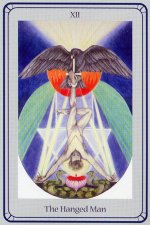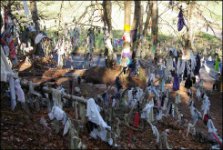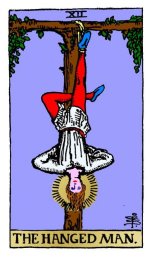The Guided Hermit
VIA Tarot
Card name—The Hanged Man
First impressions—The VIA Major XII (The Hanged Man) follows the VIA’s design convention: the center line and the goblet. The card is comprised 9 major design elements.
From the top of the card, a downward funnel of light descends in 9 rays of yellow-white light, forming the background to an open winged sea eagle. The eagle looks down at the hanged man below. The eagle holds an upside down Ansate cross (Ankh) in its talons. The loop of the cross is the point of contact for the Hanged Man—his left foot is held in the cross.
The Hanged Man is nude but lacking genitalia. As stated, his left foot is held in place in a cross rather than the typical rope seen in RWS themed decks. In addition, it is the left leg that is extended rather than the right. In the VIA, right leg is bent at 90 degrees, crossing behind the left.
Looking down the Hanged Man’s body, what is readily apparent is the figures musculature. The artist also applied two pairs of thin red lines that converge over the Hanged Man’s body. One set of lines meet between his legs; the other meet above his navel. These lines add to the strong angular aspect of this Hanged Man.
The Hanged Man is looking upward towards the eagle, however there is no indication that he wishes to escape his situation.
With his arms spread wide, the Hanged Man’s hands are nailed to the Earth. His head is suspended a short distance from the ground while two drops of blood fall into a blood filled open lotus. The lotus is guarded by two curled green snakes.
Background images include a partial sphere of fire that is in line with the bottom of the sea eagle’s wings. From the outer edges of this sphere of flame emerge flowing arcs of turquoise and yellow striped light. Immediately below the sphere, beams the thick and some thinner white light take shape, forming a square that rests on top the elemental sign for Water. This Water triangle dips into the blood filled lotus beneath the head of the Hanged Man.
What the CREATOR says —Enforced sacrifice, punishment and loss. Viewed in a more balanced way, the card is one of transition and renunciation, elements of upheaval and dramatic change.
Traditional Keyword Meanings (Bunning)—Letting go; reversal; suspension; sacrifice
Images and Symbolism—
• The Hanged Man is suspended in the posture called “The Sleep of Siloam” where the body is in the shape of a triangle.
• The Hang Man’s shape represents the descent of redeeming light into the darkness of matter.
• As the element of this path is water, two elongated water hexagrams form the backdrop to the image.
• The red disc behind the sea eagle is that of Geburah*
• The blood that drips from the head of the Hanged Man into the lotus chalice is in accordance with the demand of Our Lady Babalon(1) that we offer “Last drops of our blood into her cup of universal life.”
• The two coiled snakes, along with the eagle, are animal correspondences of the Mem(2) path.
*The fifth of the Sephirot of the tree of life, and it is the second of the emotive attributes of the Sephirot. Gevurah is known as "strength, "judgment", "power", and "concealment".
(1) Through the twists of research, this refers to The Whore of Babylon or "Babylon the great"—a Christian allegorical figure of evil mentioned in the Book of Revelation in the Bible.
(2) The element of water and the path between Geburah and Hod on the Tree of Life.
Spirit – How I relate spiritually to this card:
I relate to this card as a chance for spiritual advancement and a key that opens the gateway to personal enlightenment. This is a beautiful card for someone with a mature, spiritual outlook.
Emotional – How I relate emotionally to this card:
The concept of hanging upside down isn’t a pleasant one. However, there is great reward in the act. Once it is realized that one need to literally hang upside down to obtain the rewards symbolized in the card, the card has a very strong pull on my emotions, and a favorable one at that. I see the “self-sacrifice” of card as something deep and profoundly personal on the spiritual level of oneself. I think it is beautiful.
Physical – My physical connection to this card:
I suffer from claustrophobia. I’m grateful that I don’t need to be tied down to reach enlightenment!
Beneficial – I feel the most beneficial aspect of this card is…
The opportunity this card affords.
Problematic – I feel the most problematic aspect of this card is….
A potential for stagnation if the Querent does-not apply what this card suggests.
What the card means to me—I see this card in a very favorable light. I see it as a card of tremendous opportunity for growing in one’s inner silence. This card allows the Querent to let the speeding world speed by. It takes the rat out of the race. This is a time to see the world in a new manner and in looking at the world as a tightly defined and stationary position; it allows one to see the bigger picture. This card tells the Querent to stop and take a closer look at what is happening within and around them. This is a card that grants one the freedom to say no to the outside world and to evolve by doing so.
Card name—The Hanged Man
First impressions—The VIA Major XII (The Hanged Man) follows the VIA’s design convention: the center line and the goblet. The card is comprised 9 major design elements.
From the top of the card, a downward funnel of light descends in 9 rays of yellow-white light, forming the background to an open winged sea eagle. The eagle looks down at the hanged man below. The eagle holds an upside down Ansate cross (Ankh) in its talons. The loop of the cross is the point of contact for the Hanged Man—his left foot is held in the cross.
The Hanged Man is nude but lacking genitalia. As stated, his left foot is held in place in a cross rather than the typical rope seen in RWS themed decks. In addition, it is the left leg that is extended rather than the right. In the VIA, right leg is bent at 90 degrees, crossing behind the left.
Looking down the Hanged Man’s body, what is readily apparent is the figures musculature. The artist also applied two pairs of thin red lines that converge over the Hanged Man’s body. One set of lines meet between his legs; the other meet above his navel. These lines add to the strong angular aspect of this Hanged Man.
The Hanged Man is looking upward towards the eagle, however there is no indication that he wishes to escape his situation.
With his arms spread wide, the Hanged Man’s hands are nailed to the Earth. His head is suspended a short distance from the ground while two drops of blood fall into a blood filled open lotus. The lotus is guarded by two curled green snakes.
Background images include a partial sphere of fire that is in line with the bottom of the sea eagle’s wings. From the outer edges of this sphere of flame emerge flowing arcs of turquoise and yellow striped light. Immediately below the sphere, beams the thick and some thinner white light take shape, forming a square that rests on top the elemental sign for Water. This Water triangle dips into the blood filled lotus beneath the head of the Hanged Man.
What the CREATOR says —Enforced sacrifice, punishment and loss. Viewed in a more balanced way, the card is one of transition and renunciation, elements of upheaval and dramatic change.
Traditional Keyword Meanings (Bunning)—Letting go; reversal; suspension; sacrifice
Images and Symbolism—
• The Hanged Man is suspended in the posture called “The Sleep of Siloam” where the body is in the shape of a triangle.
• The Hang Man’s shape represents the descent of redeeming light into the darkness of matter.
• As the element of this path is water, two elongated water hexagrams form the backdrop to the image.
• The red disc behind the sea eagle is that of Geburah*
• The blood that drips from the head of the Hanged Man into the lotus chalice is in accordance with the demand of Our Lady Babalon(1) that we offer “Last drops of our blood into her cup of universal life.”
• The two coiled snakes, along with the eagle, are animal correspondences of the Mem(2) path.
*The fifth of the Sephirot of the tree of life, and it is the second of the emotive attributes of the Sephirot. Gevurah is known as "strength, "judgment", "power", and "concealment".
(1) Through the twists of research, this refers to The Whore of Babylon or "Babylon the great"—a Christian allegorical figure of evil mentioned in the Book of Revelation in the Bible.
(2) The element of water and the path between Geburah and Hod on the Tree of Life.
Spirit – How I relate spiritually to this card:
I relate to this card as a chance for spiritual advancement and a key that opens the gateway to personal enlightenment. This is a beautiful card for someone with a mature, spiritual outlook.
Emotional – How I relate emotionally to this card:
The concept of hanging upside down isn’t a pleasant one. However, there is great reward in the act. Once it is realized that one need to literally hang upside down to obtain the rewards symbolized in the card, the card has a very strong pull on my emotions, and a favorable one at that. I see the “self-sacrifice” of card as something deep and profoundly personal on the spiritual level of oneself. I think it is beautiful.
Physical – My physical connection to this card:
I suffer from claustrophobia. I’m grateful that I don’t need to be tied down to reach enlightenment!
Beneficial – I feel the most beneficial aspect of this card is…
The opportunity this card affords.
Problematic – I feel the most problematic aspect of this card is….
A potential for stagnation if the Querent does-not apply what this card suggests.
What the card means to me—I see this card in a very favorable light. I see it as a card of tremendous opportunity for growing in one’s inner silence. This card allows the Querent to let the speeding world speed by. It takes the rat out of the race. This is a time to see the world in a new manner and in looking at the world as a tightly defined and stationary position; it allows one to see the bigger picture. This card tells the Querent to stop and take a closer look at what is happening within and around them. This is a card that grants one the freedom to say no to the outside world and to evolve by doing so.



 More Prudence. The Etteilla decks were really big on it.
More Prudence. The Etteilla decks were really big on it. 
